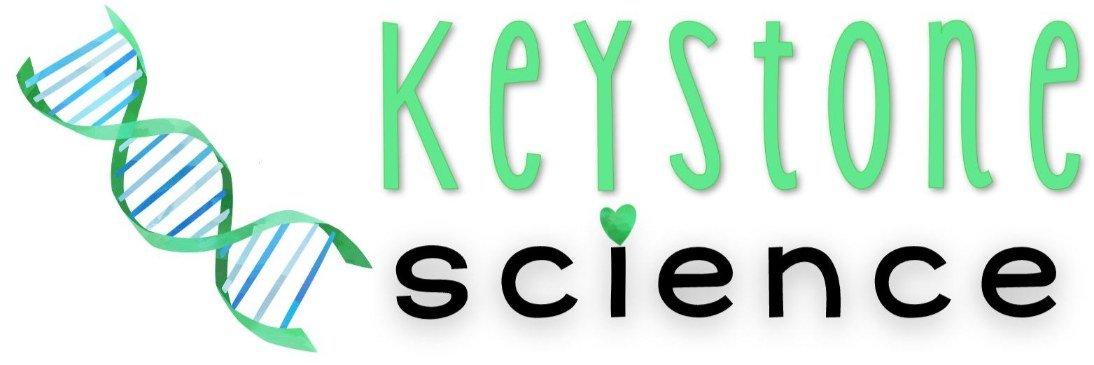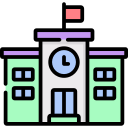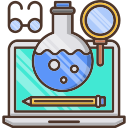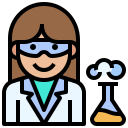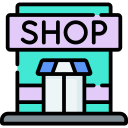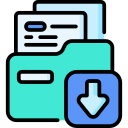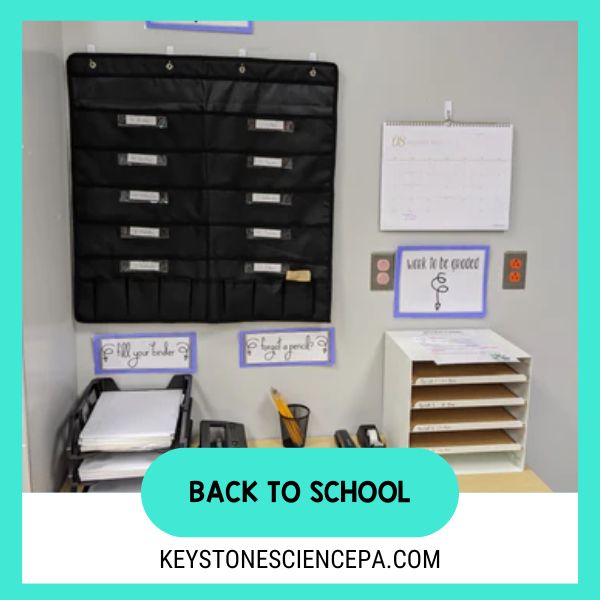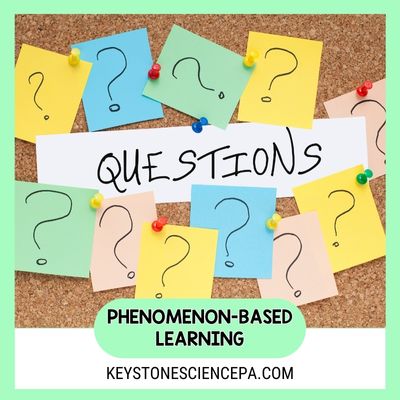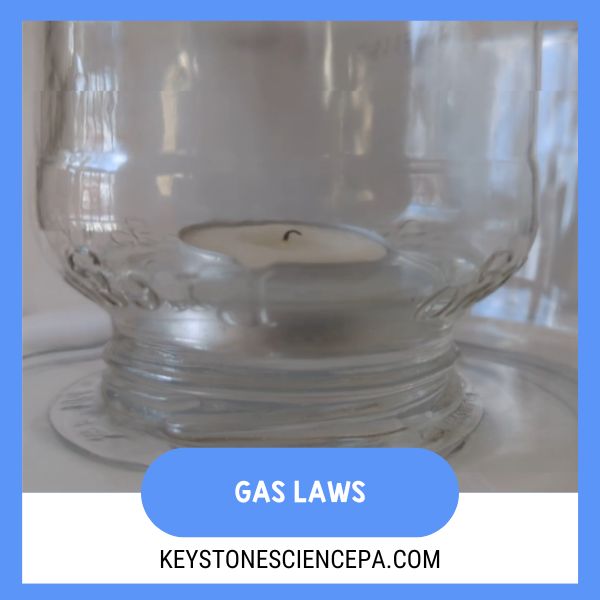Disclosure: This post may contain affiliate links, meaning I get a commission if you decide to make a purchase through my links, at no cost to you.
Ok teachers, it’s time to get in teacher mode and I have the perfect guide in this Back to School blog series Part 2! Here I will lay out some of my favorite science classroom organization tips that will have you setting up your classroom like a pro:
- How to organize lab supplies
- Creating a classroom student center
- Classroom bulletin board
- Teacher desk setup
- How to make a classroom science library
In case you need a review of part 1 of the Back to School series: 5 Steps to Update Curriculum Over the Summer, here we focused more on reviewing the past year and looking at what worked and what part of the curriculum needs refreshing.

Taking the time to update science curriculum is a task so many of us push to the side because looking at an entire school year’s worth of curriculum can feel beyond overwhelming! Even if we know what needs to be updated, just trying to figure out where to start is enough to push this off to the later pile.
I know, I’ve been there 🙄
That’s why I wanted to share this 👉 FREE Step-by-Step Guide to Curriculum Updates where I walk you through how to update science lessons in 5 steps! This 10-PAGE curriculum outline breaks down each step covered in the Back to School series: Part 1 blog and is filled with graphic organizers to keep your ideas in an easy-to-read layout.

So while Part 1 focused on updating science lessons, part 2 is all about classroom organization and providing actionable steps to set up systems that actually work!
Importance of Setting Up Your Classroom
One of the best parts of a new school year is to be able to start on a clean slate and to take the time to really think about how you want your classroom to flow.
Creating an organized science classroom goes beyond cute labels and bins. Instead, you are actually setting up an environment where you AND your students will benefit from having clear systems in place.
Keep on reading, because we’re going to look at how to set up a classroom designed for success by designing:
- Easy-to-access student resources
- Student independence
- Reduced student stress
- Increased teacher efficiency

Lab Supply Storage and Accessibility
This one is especially for science teachers! One of the main struggles with finding ways to organize all of those lab supplies is to make a system that allows for the storage to be easy to access.
STORAGE BINS 📦
First step in setting up a lab supply storage is to determine the space you have available to you.
Next, use clear labeled bins or drawers for different types of supplies. If you prefer to use collapsible storage cubes, 👈these are the one I use!
💡TIP: To label storage cubes, write the contents on an index card and paperclip it to the bin
Considering the cabinet space you have available, I like to categorize storage into 3 categories:
- Student items: Easiest to access
- Lab supplies: Organize by unit
- General supply: Holds frequently used items such as soap, baking soda, salt, dice, cups, toothpicks, beans, etc.
💡TIP: When moving lab supplies around the room, consider using a rolling cart
LAB SUPPLY CHECKLIST☑️
Once all classroom and lab supplies have been categorized, create a lab supply checklist to help keep track of inventory and which teacher has “checked out” which item(s).
Airtable (affiliate link) is an excellent way to manage a running spreadsheet of lab equipment, breakage list and itemize by group, class or section so you know how much to order. It’s way easier to operate than Excel or Sheets and let’s you quickly organize content.
Student Center
Designating an area in the classroom as the student center is an excellent way to make sure organization is maintained not just for you, but your students also.
By creating a hub for turning in assignments, getting absent work, extra pencils, paper, highlighters, etc., students can take more independence in managing their work, hence creating a more effective learning environment!
Here are a few ideas for setting up a classroom student center:
- Labeled bins, trays, or folders: Turn-in, late work, absent work folder
- Here is my favorite space-saving bin: Ikea Kvissle Letter tray
- Include a station for additional supplies: Pencils, pens, erasers, stapler, 3-hold punch, graph paper, extra paper, tape, pencil sharpener,
- Subject calendar or schedule for quick reference of what was covered each day
- This calendar from Amazon is VERY cute and I may use it this year instead of my usual Target calendar!
- The student center should be EASY to see: In my classroom, it is a straight shot from the door. As soon as students walk in, it’s the first thing they see.

There are so many ways these can all be stored! Take a look at the items I use to help organize my student center:
📄Paper storage for blank, graph or colored paper (Mine are plastic now, but I’ll be using this to help move towards a plastic free classroom)
✏️The BEST pencil sharpener around
📂Sturdy cardboard magazine holder for student folders
Teacher Desk
It’s one thing to find a way to have our students help stay organized, it’s a whole other beast when trying to find the most functional way to organize a teacher desk!
Not only is it a space that holds a laptop or desktop, but you also need to create a space for planning, grading, and managing classroom activities.
Similar to the set up for a student center, think about what items you frequently use and keep those within close reach.
Will papers and personal items have a place on the desk or can drawers be used instead to help clear space?
Below is a very old picture of my desk, but the setup has not changed much in the 4 years I’ve been back in the classroom!

I’ve created a space for technology, frequently used items, and important documents. Read below the picture where I’ve detailed how each space is used.
⬅️Left: File organizer for sub folder, seating charts, lesson plans, curriculum, standards, the periodic table, etc.
💡TIP: I buy cute folders for these things because I use them all the time and a cute folder really lifts my spirits, ya know?
⬆️Middle: Laptop wireless keyboard that fits under laptop so I have clear space to grade and do paperwork, etc.
💡TIP: Not pictured, but I started using a laptop stand to elevate it, creating more space
- My FAVORITE laptop stand
- Tablet stand: I use this at home
- Wireless keyboard and mouse: My students love it, it comes in SO MANY COLORS, plus I get compliments all the time!
➡️Right: Second monitor (cannot live without), pen/pencil cup, at-a-glance month calendar, coffee (is life), pile of papers to grade
💡TIP: I’ve nixed the paper lesson planner for a digital one! Do you ant the one I use? Send me an email and let me know: [email protected]
- Portable monitor
- Science Teacher Coffee Cup (of course 😉)
🗄️Teacher Desk Drawers:
- Top drawer: Frequently used items like my laser pointer, paper clips, highlighters, chapstick, gum, etc.
💡TIP: Use drawer organizers inside to keep items in place
- Middle drawer: Sticky notes, extra note paper/notebooks, label maker
- Bottom drawer: Snacks, word wall signs organized by unit, and other organizational paperwork/checklists like beginning-of-year to-do lists, budget spreadsheets, and end-of-year checklists for easy access.
Science Prep Table
I would argue that the science prep table is even more important than a teacher desk, especially if you are teaching more than 1 prep!
Below is my room on the first day of school last year, when I had two preps (AKA 2 subjects).

Materials for one prep were ALWAYS on the left side of the prep table and materials for my other prep were ALWAYS on the right side.
Seating charts should be easy to access and all supplies are front and center.
On lab days the prep table should be cleared off so all lab materials have space and do not mess up the papers!
The cabinet underneath my prep table (not pictured) has a huge paper organizer where I keep tests, quizzes, correction papers, bubble sheets, etc.
💡TIP: I also have a smaller file organizer for copies I’ve made in advance so they don’t clutter up my table too much.
Bulletin Boards
Creating a class bulletin board with timely information and important reminders is another great element to add in your room because again, it creates independence for students.
Of course, it would be a dream if we could expect them to review the board everyday!
But in reality, even just using a quick reference to the bulletin board during announcements or on the daily agenda could be enough for them to glance at it and find whatever information they need from it.
This is what I suggest highlighting with up-to-date information for students:
- School calendar, day of the cycle, upcoming events, announcements, etc.
Here’s what I use to get my students to attention to the bulletin board:
- Use a LARGE, visible space that students can easily access.
- Regularly update the board with new information and reminders.
- Incorporate colorful and eye-catching elements to draw students’ attention.
Science Themed Bulletin Board
If you have an additional bulletin board, or even just a large blank wall, I would HIGHLY suggest incorporating a science-themed bulletin board also.
Why? It’s a great way to keep the class engaged in what’s been covered, display student work, share interesting science facts, upcoming science events, volunteer opportunities, etc.
I would even encourage students to contribute content to the bulletin board. Trust me, all those artistic students you have in class LOVE to see their science art displayed!
Science Library
Similar to having an engaging bulletin board, creating space for a science library in the classroom is a fun piece to add!
Don’t worry about making this space too serious. Yes, you want to provide textbooks and science journals, but why not add fun, weird or crazy discoveries to the science library too 😜. As long as it’s a space that keeps students engaged and wanting to sift through, then add it.
If you’ve been on the fence about adding a science library to your classroom, then take a look at the Science Book Round Up blog. It’s a quick read with listed benefits to how a science library can enhance student learning.
Aside from the literature, the environment is just as important to making students WANT to go to this space.
- Include a variety of resources catering to different interests and reading levels.
- Organize books by category or subject, for easy navigation.
- Create a cozy and inviting reading area with comfortable seating, lights, pillows, etc.
Conclusion
We can all agree that nothing feels better than having a well-organized classroom and teacher space to kick-start a productive school year!
I hope these tips and peeks into how I organize my classroom gave you inspiration into how you can make your learning space most effective.
If you have a classroom setup tip or idea that you love using, feel free to share it below in the comments section!
Preview of Next Post
Next week, I’m excited to share with you that there will be a GUEST blog post by Katrina Harte, The Animated Teacher, who will be sharing her 11 tips for only working during contracted hours!
Maintaining healthy work boundaries is something so many of us struggle with, so this next post will be a must read! Stay tuned…
Just a reminder– If you are looking for fresh ideas and easy-to-use classroom strategies, then I know you will LOVE Keystone Science!
To be the first to know when the next Back to School series posts, FREEBIES, and other tips, I would love for you to join the Keystone Science Community!
If you’re wanting more, here you go:
💡Feel free to explore Keystone Science for ready-to-use high school biology & ecology NGSS-aligned notes and activities.
💡Subscribe to my email list for weekly tips direct to your inbox.
💡Follow me on Instagram for daily tips, motivation, and facts you can use in your classroom!
🌟Share in the comments or email me directly 👉🏻 [email protected]
